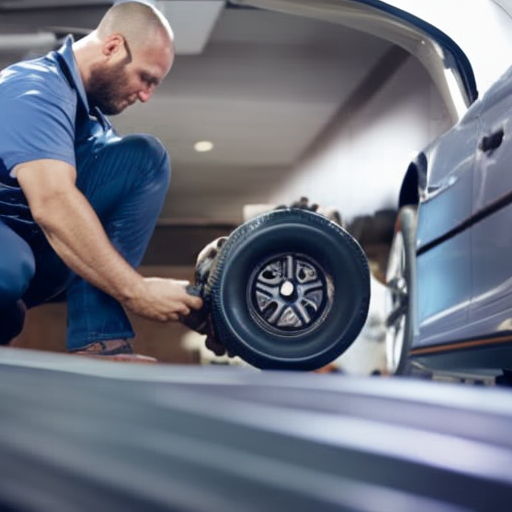"Cherishing Little Steps - A Haven for Baby and Family Journeys"
Child-Friendly Vehicle Safety Tips
So, you’ve finally decided to take your little ones on a road trip. How exciting! But before you hit the road, it’s important to make sure you’re equipped with the right knowledge to keep your kids safe and sound.
Introducing our child-friendly vehicle safety tips – your ultimate guide to ensuring a smooth and secure journey for your precious cargo. From properly using child restraints to choosing the right car seat and installing it correctly, we’ve got you covered.
We’ll also show you how to adjust seat belts for children, secure loose items in the vehicle, and stay updated on vehicle recalls and safety ratings. Plus, we’ll give you some valuable advice on planning for long car trips and dealing with emergencies on the road.
Remember, your little ones deserve the utmost care and attention, even in the car. So, let’s buckle up and embark on this safety adventure together!
Key Takeaways
- Choose the right car seat based on your child’s age, weight, and height.
- Secure all loose items in your vehicle to minimize the risk of them becoming projectiles during a collision.
- Minimize distractions and teach good passenger behavior to ensure the safety of your child.
- Regularly check for vehicle recalls and safety ratings, and prioritize regular maintenance to keep your child safe.
Proper Use of Child Restraints
Make sure you buckle up your child securely in their car seat to ensure their safety while traveling. Following child restraint guidelines is crucial for protecting your little one in the event of a car accident.
One important guideline to keep in mind is the use of rear-facing seats. Rear-facing seats provide the best protection for infants and young children because they support their head, neck, and spine. This is especially important for babies, whose neck muscles aren’t fully developed. In a rear-facing car seat, the force of a crash is distributed evenly across the child’s back, reducing the risk of injury.
The American Academy of Pediatrics recommends keeping your child in a rear-facing seat until they reach the maximum weight or height limit specified by the car seat manufacturer. This usually means keeping them rear-facing until they’re at least two years old.
Choosing the Right Car Seat
To ensure the safety of your child while traveling, it is important to choose the right car seat. A car seat is one of the most crucial safety devices you can provide for your child when driving. It not only protects them in the event of a crash but also keeps them secure and comfortable during the journey. Here are some essential tips to help you choose the right car seat for your child:
| Age Range | Type of Car Seat | Installation |
|---|---|---|
| Infants | Rear-facing | Base and seat |
| Toddlers | Forward-facing | Seatbelt or LATCH system |
| Preschoolers | Booster Seat | Seatbelt or LATCH system |
When it comes to car seat safety, always follow the manufacturer’s instructions for installation. Ensure that the car seat is securely fastened and does not move more than an inch in any direction. Double-check that the harness straps are snug and positioned correctly. Remember to adjust the car seat as your child grows to ensure maximum safety and comfort.
Investing in a high-quality car seat and properly installing it is one of the best ways to protect your child while on the road. Keep in mind that car seat safety should never be compromised, as it can greatly reduce the risk of injury in the event of an accident.
Installing Car Seats Correctly

Ensure the safety of your child by correctly installing their car seat. Proper installation is crucial to ensuring that the car seat is effective in protecting your child in the event of an accident. To ensure correct installation, it’s important to follow the safety regulations provided by the car seat manufacturer and your vehicle’s owner’s manual.
Start by carefully reading the instructions that come with your car seat. These instructions will provide step-by-step guidance on how to install the seat correctly. Make sure you understand each step before you begin the installation process.
Next, familiarize yourself with your vehicle’s owner’s manual. This will provide specific information on how to install a car seat in your particular vehicle. It may include details on where to place the car seat, how to secure it properly, and any additional safety requirements to keep in mind.
When installing the car seat, ensure that it’s securely fastened and doesn’t move more than an inch in any direction. Check for tightness by firmly grasping the seat at the base and trying to move it. If it moves excessively, adjust the installation until it’s secure.
Correct installation of a car seat is crucial to your child’s safety. By following the manufacturer’s instructions and your vehicle’s owner’s manual, you can ensure that your child is protected in the car. Remember to always check the installation regularly to ensure that the seat remains secure.
Adjusting Seat Belts for Children
Adjust the seat belts to properly fit your child for maximum safety in the vehicle. Adjusting seat belts for infants and young children is crucial to ensure their safety while traveling. According to car seat safety guidelines, it’s important to follow specific steps to ensure a secure fit.
First, make sure the lap belt rests low and snug across your child’s upper thighs, and not on their stomach. This helps distribute the force of a crash and reduces the risk of injury. Next, the shoulder belt should cross their chest and shoulder, without touching their neck or face. Adjust the seat belt height to ensure a proper fit, and make sure it’s not twisted.
For infants, always use a rear-facing car seat and read the manufacturer’s instructions carefully. Remember to place the car seat in the back seat of the vehicle, away from active airbags. As your child grows, transition them to a forward-facing seat and eventually a booster seat when they meet the height and weight requirements.
Regularly check the fit of the seat belts as your child grows to ensure ongoing safety. By adjusting the seat belts correctly, you can provide your child with the utmost protection during every journey.
Securing Loose Items in the Vehicle
Secure all loose items in your vehicle to minimize the risk of them becoming projectiles during a collision. It’s important to create a safe environment for your child, not only by properly securing them, but also by ensuring that loose items are secured as well. Here are three ways to keep things in place and prevent any potential hazards:
-
Use organizers: Invest in car organizers to keep items neatly stored and secured. These organizers can hold toys, books, snacks, and other essentials your child may need during the journey. They come in various sizes and designs, allowing you to choose one that best fits your vehicle and your child’s needs.
-
Utilize seatback storage: Many vehicles have seatback storage compartments that can be incredibly useful for keeping items organized and within reach. Use these compartments to store items like water bottles, wipes, and small toys. This way, everything is easily accessible and won’t cause any distractions or injuries in case of sudden movements.
-
Consider motion sickness prevention: Motion sickness can be a common issue for children during car rides. To prevent this, avoid placing loose items that may move around and contribute to nausea. Instead, opt for digital entertainment devices with headphones or tablets that can be securely mounted in place. This not only prevents motion sickness but also keeps your child entertained throughout the journey.
Minimizing Distractions While Driving
To maintain a safe environment for your child, it’s crucial to limit distractions while driving. Minimizing distractions not only keeps you focused on the road, but it also ensures the safety of your little ones.
One of the most important distractions to avoid is phone use. It’s tempting to check your phone when you hear a notification or receive a call, but it only takes a split second of looking away to cause an accident. To prevent this, put your phone on silent or turn it off completely while driving. If you need to use your phone for navigation, invest in a hands-free device or use a voice-controlled system.
Teaching Good Passenger Behavior
Ensure a safe and enjoyable ride for your child by teaching them proper behavior as passengers in the vehicle. Here are a few tips to help you teach communication skills and promote positive behavior:
-
Lead by Example: Children learn a lot by observing their parents. Show them how to be a good passenger by wearing your seatbelt, following traffic rules, and using polite and respectful language while in the car.
-
Set Expectations: Clearly communicate your expectations regarding their behavior in the car. Let them know that they need to remain seated, keep their voices at an appropriate volume, and avoid distracting the driver.
-
Encourage Communication: Teach your child how to communicate their needs effectively without causing distractions. Encourage them to use words instead of whining or shouting, and remind them that the driver needs to focus on the road.
By teaching these communication skills and promoting positive behavior, you can help your child become a responsible and considerate passenger. This not only ensures their safety but also creates a more pleasant environment for everyone in the vehicle.
Creating a Safe Environment in the Car
To promote safety while traveling with your child, it’s important to establish a secure environment in the car.
Creating a calm atmosphere can help reduce distractions and keep your child focused on the road ahead. Start by ensuring that the car is clean and free from any potential hazards. Remove any loose objects that could become projectiles in the event of sudden braking or a collision.
Motion sickness is a common issue that many children experience while traveling in a car. To prevent motion sickness, try to minimize sudden stops and starts, as well as sharp turns. Encourage your child to look out the window at a fixed point in the distance to help stabilize their balance. Additionally, providing your child with a light snack before the journey and avoiding heavy meals can also help alleviate symptoms.
Consider playing soothing music or audiobooks to create a relaxing atmosphere in the car. This can help distract your child from any potential anxiety or restlessness. If your child enjoys technology, you can also provide them with a tablet or portable gaming device to keep them entertained during the ride.
Checking for Vehicle Recalls and Safety Ratings
Stay informed about vehicle recalls and safety ratings to prioritize your child’s safety on the road. It’s important to regularly check for any recalls on your vehicle to ensure that it’s in optimal condition. Here are three steps to help you stay on top of vehicle recalls:
-
Check for Recalls:
Visit the National Highway Traffic Safety Administration (NHTSA) website and enter your vehicle’s make, model, and year to see if any recalls have been issued. Keep in mind that recalls can range from minor issues to serious safety concerns, so it’s crucial to address them promptly. -
Schedule Repairs:
If a recall is issued for your vehicle, contact your local dealership to schedule the necessary repairs. Remember, recalls are free of charge, and it’s essential to address them as soon as possible to ensure your child’s safety. -
Research Safety Ratings:
In addition to checking for recalls, it’s also important to research the safety ratings of different child seats. Look for seats that have been tested and approved by organizations such as the NHTSA or the Insurance Institute for Highway Safety (IIHS). These ratings can give you valuable information about the effectiveness and reliability of different child seats.
Planning for Long Car Trips With Children

When planning for long car trips with children, it’s important to consider their comfort and entertainment options. Keeping kids entertained during those hours on the road can make the journey more enjoyable for everyone involved.
To keep the boredom at bay, try incorporating fun car games for children. Classic games like ‘I Spy,’ the license plate game, or the alphabet game can keep them engaged and entertained.
Another option is to bring along books, coloring books, or activity kits to keep their minds occupied. Don’t forget to pack their favorite snacks and drinks to keep their tummies happy.
It’s also a good idea to schedule regular stops along the way to stretch their legs and burn off some energy. If possible, plan the trip during their naptime or bedtime to maximize their comfort and minimize restlessness.
Dealing With Emergencies on the Road
Be prepared for emergencies by keeping a well-stocked emergency kit in your vehicle.
Emergencies can happen when we least expect them, especially when we’re on the road. It’s crucial to be prepared for unexpected situations like tire blowouts or even car fires. Here are some tips to help you handle these emergencies and keep your child safe:
-
Dealing with tire blowouts:
- Stay calm and maintain control of the vehicle. Avoid sudden braking or steering.
- Slowly ease off the accelerator and let the car gradually come to a stop on the side of the road.
- Use hazard lights and reflective triangles to alert other drivers of your presence.
-
Handling a car fire:
- Safely pull over to a safe location away from traffic and turn off the engine.
- Evacuate your vehicle and move yourself and your child to a safe distance.
- Call emergency services immediately and don’t attempt to put out the fire yourself.
Regular Maintenance and Inspections of the Vehicle

To ensure the safety of your child, it’s important to regularly maintain and inspect your vehicle. Regular maintenance is crucial to keep your vehicle in good working condition. This includes routine tasks such as oil changes, tire rotations, and brake inspections. By staying up-to-date with these maintenance tasks, you can help prevent any potential issues that may arise while driving with your child.
In addition to regular maintenance, vehicle inspections are equally important. Inspecting your vehicle ensures that all components are functioning properly and that there are no potential safety hazards. This includes checking the lights, wipers, and brakes, as well as inspecting the tires for any signs of wear or damage.
By regularly maintaining and inspecting your vehicle, you can minimize the risk of unexpected breakdowns or accidents. It’s recommended to follow the manufacturer’s guidelines for maintenance and inspections, as they provide specific instructions tailored to your vehicle.
Frequently Asked Questions
What Are the Most Common Mistakes Parents Make When Installing a Car Seat?
You’re not alone in making common mistakes when installing a car seat. It’s essential to learn proper installation techniques to ensure your child’s safety. Let’s explore some tips together.
How Can I Ensure That My Child’s Car Seat Is the Right Size for Them?
To ensure your child’s car seat is the right size, consider their age, height, and weight. Follow car seat safety guidelines, and choose the right car seat accordingly. It’s crucial for their safety and protection.
Are There Any Special Considerations for Installing Car Seats in Older Vehicles?
When installing car seats in older vehicles, there are special considerations to keep in mind. Ensure that the seat is securely anchored and that the vehicle’s seat belts are in good condition. Safety first!
How Can I Prevent My Child From Unbuckling Their Seat Belt While Driving?
To prevent your child from unbuckling their seat belt while driving, try these tips: make sure the seat belt is properly adjusted and snug, use a seat belt buckle guard, and teach your child the importance of seat belt safety.
Is It Safe for Children to Bring Toys or Other Items in the Car?
Bringing toys in the car might seem like a fun idea, but safety concerns arise. Loose objects can become projectiles during sudden stops or accidents, potentially causing harm. It’s better to prioritize your child’s safety over playtime.
Conclusion
Now that you have all the child-friendly vehicle safety tips at your fingertips, you can hit the road with confidence.
By properly using child restraints, choosing the right car seat, and installing them correctly, you’re taking important steps to keep your little ones safe.
Remember to secure loose items and stay updated on vehicle recalls and safety ratings.
And don’t forget to plan ahead for long trips and be prepared for emergencies.
With these precautions in place, you can enjoy worry-free travels with your precious cargo.


